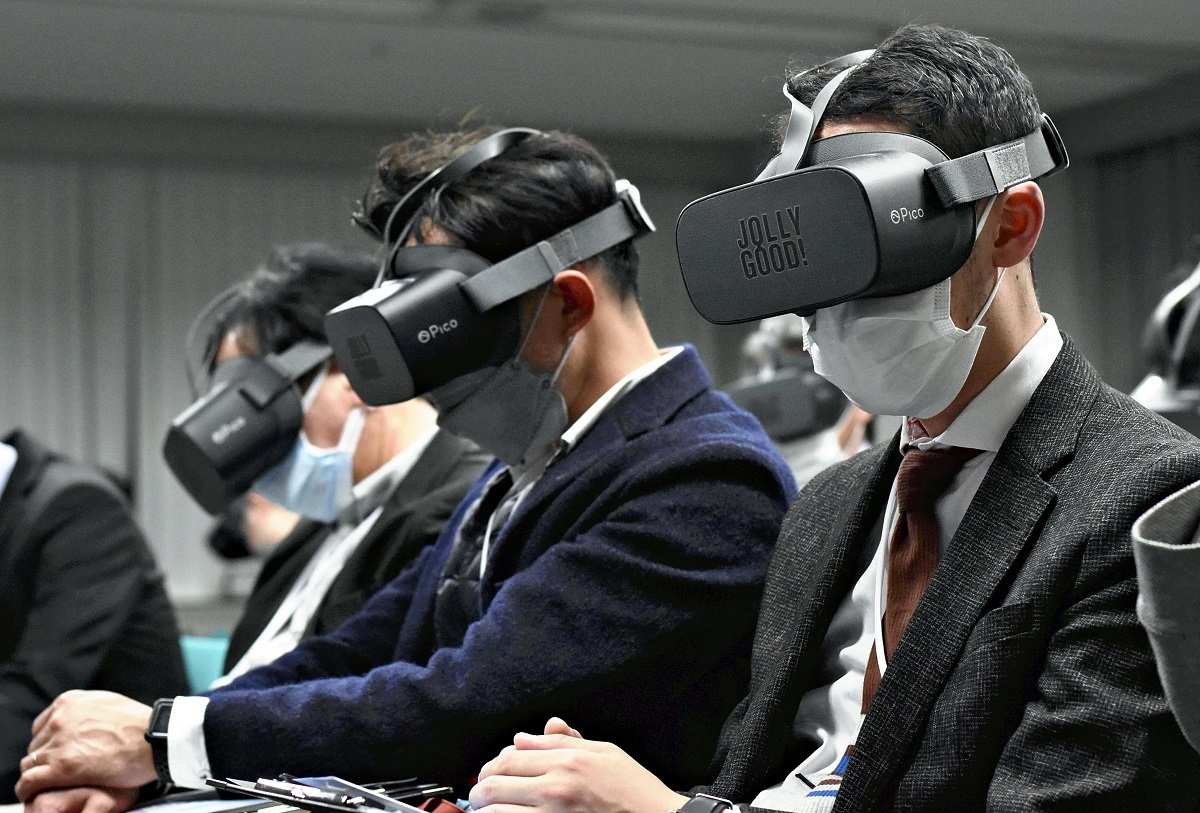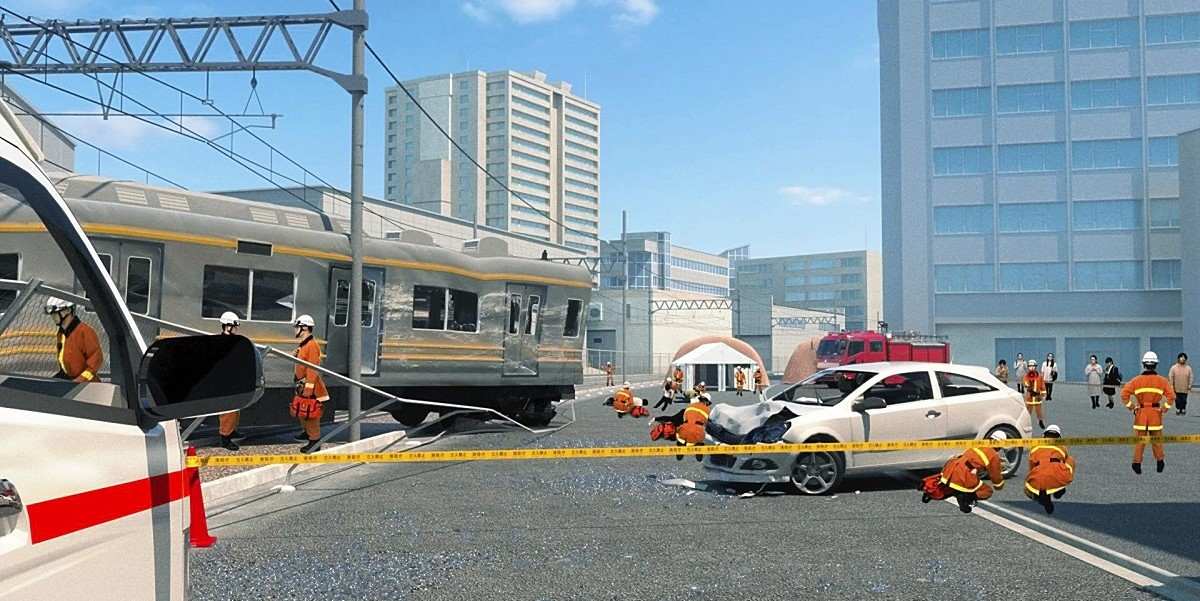
Attendees at a seminar held in Morioka on March 9 wear goggles to learn what they should do in the event of a large-scale accident from the perspective of doctors.
20:00 JST, April 26, 2023
MORIOKA — Kumamoto University and a production company have jointly developed virtual reality-based educational material that allows people to learn how to rescue individuals involved in a train derailment. The material is modeled after a derailment on the JR Fukuchiyama Line that took place 18 years ago.
In the accident on April 25, 2005, a seven-car rapid train derailed in Amagasaki, Hyogo Prefecture, and crashed into an apartment building on the side of the track, claiming 107 lives, including a train driver, and injuring 562 more. More than 100 doctors, nurses and other medical personnel worked to save lives and treat the injured at the scene and at nearby medical facilities.
The 360-degree view of the accident scene displayed in the material allows people to learn what they should do in the event of a large-scale accident from the perspective of doctors. The university put the material to use for student training this month. Those who developed the material hope it will help students deepen their understanding of medical actions required in the event of massive disasters and accidents.
In March, about 80 people, including medical workers, tried out the VR material at a general meeting of the Japanese Association for Disaster Medicine held in Morioka. The attendees of a disaster medical education VR seminar put on goggles upon hearing announcements such as “An earthquake measuring upper 6 [on the Japanese seismic intensity scale of 7] has occurred” and “Dispatch of rescue squad requested.”
Subsequently, an alarm sounded and audio reporting of the accident scene was heard. An image of a derailed and crushed train lying on the side of the track was displayed.
The 20-minute video was jointly produced by Kumamoto University and Tokyo-based VR production company Jolly Good Inc. The Fukuchiyama Line derailment was caused by the train greatly exceeding the speed limit when entering a curve. However, the VR teaching material vividly depicts the scene and injuries using computer graphics of a train derailment scenario and numerous injuries caused by a major earthquake.
Users of the material can learn about the process of organizing a first-aid team, triage – which prioritizes medical treatment based on degree of injury – and transport to a hospital for emergency treatment, while answering questions on things to pay attention to, as well as medical procedures.
“[The VR material] was very realistic and I felt as if I were in the ambulance,” Fumiko Watanabe, 56, an assistant professor who teaches disaster nursing at Aino University Junior College in Osaka Prefecture, said.

A derailment scene vividly depicted by computer graphics
In recent years, taking appropriate medical actions to address large-scale natural disasters and accidents has become more important than ever due to an increase in such tragedies. However, it is difficult for medical workers to receive training in the field. Therefore, VR is being utilized for this purpose.
A considerable portion of the VR material is allotted to scenes of doctors giving instructions to the medical team, as well as seeking instructions from the fire department at the command headquarters.
The reason for this is a lesson learned from the Fukuchiyama Line derailment. When the tragedy happened, the injured were brought out to the side of the rail track without adequate preparation. Additionally, poor information sharing among many medical teams, and officers from fire departments and the police rushing to the scene from various parts of the prefecture resulted in a lack of understanding of the whole picture, which caused confusion at the scene.
Makoto Kobayashi, 54, assistant director of Tottori Prefectural Central Hospital, who was an emergency physician at Hyogo Emergency Medical Center and was in charge of supervising the medical team at the time of the deadly derailment, said: “The importance of a commander to control different teams became clear [at the accident]. It’s invaluable to pass on the lessons learned to the next generation through educational VR materials.”
“Accidents like the train derailment can happen at any time. We’d like to prepare for them and help prevent [knowledge of] the accident 18 years ago from fading away,” said Shunji Kasaoka, 61, director of the Disaster Medical Education and Research Center at Kumamoto University Hospital, who supervised the VR teaching material.
"Society" POPULAR ARTICLE
-

M4.9 Earthquake Hits Tokyo, Neighboring Prefectures
-

Israeli Tourists Refused Accommodation at Hotel in Japan’s Nagano Pref., Prompting Protest by Israeli Embassy and Probe by Prefecture
-

M7.5 Earthquake Hits Northern Japan; Tsunami Waves Observed in Hokkaido, Aomori and Iwate Prefectures
-

Tsukiji Market Urges Tourists to Avoid Visiting in Year-End
-

M5.7 Earthquake Hits Japan’s Kumamoto Pref., Measuring Upper 5 Intensity, No Tsunami Expected
JN ACCESS RANKING
-

Tokyo Economic Security Forum to Hold Inaugural Meeting Amid Tense Global Environment
-

Keidanren Chairman Yoshinobu Tsutsui Visits Kashiwazaki-Kariwa Nuclear Power Plant; Inspects New Emergency Safety System
-

Imports of Rare Earths from China Facing Delays, May Be Caused by Deterioration of Japan-China Relations
-

University of Tokyo Professor Discusses Japanese Economic Security in Interview Ahead of Forum
-

Japan Pulls out of Vietnam Nuclear Project, Complicating Hanoi’s Power Plans























